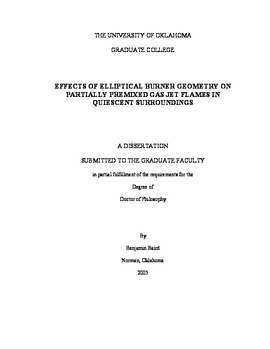| dc.contributor.advisor | Gollahalli, S. R., | en_US |
| dc.contributor.author | Baird, Benjamin. | en_US |
| dc.date.accessioned | 2013-08-16T12:19:37Z | |
| dc.date.available | 2013-08-16T12:19:37Z | |
| dc.date.issued | 2005 | en_US |
| dc.identifier.uri | https://hdl.handle.net/11244/821 | |
| dc.description.abstract | The 3:1 AR elliptical and circular burners produced similar carbon monoxide and nitric oxide emission indexes over the range of equivalence ratios of 0.55 to 4.0, for laminar flames. (Abstract shortened by UMI.) | en_US |
| dc.description.abstract | It was found that the laminar flames were similar in appearance and overall flame length for the 3:1 AR elliptical and the circular burner. The laminar 4:1 AR elliptical burner flame split into two sub-flames along the burner major axis. This splitting had the effect of greatly shortening the 4:1 AR elliptical burner flame to have an overall flame length about half of that of the circular and 3:1 AR elliptical burner flames. The length of all three burners flames increased with increasing burner exit equivalence ratio. | en_US |
| dc.description.abstract | The blowout velocity for the three burners increased with increase in hydrogen mass fraction of the hydrogen/propane fuel mixture. For the rich premixed flames, the circular burner was the most stable, the 3:1 AR elliptical burner, was the least stable, and the 4:1 AR elliptical burner was intermediate to the two other burners. This order of stability was due to two reasons. The elliptical burners have enhanced turbulence generation that lowers their stability when compared to the circular burner. The 4:1 AR elliptical burner had greater stability due to a greater velocity decay rate and wider OH reaction zones particularly in the region between the two jets. | en_US |
| dc.description.abstract | This study is the investigation of the effect of elliptical nozzle burner geometry and partial premixing, both 'passive control' methods, on a hydrogen/hydrocarbon flame. Both laminar and turbulent flames for circular, 3:1, and 4:1 aspect ratio (AR) elliptical burners are considered. The amount of air mixed with the fuel is varied from fuel-lean premixed flames to fuel-rich partially premixed flames. The work includes measurements of flame stability, global pollutant emissions, flame radiation, and flame structure for the differing burner types and fuel conditions. Special emphasis is placed on the near-burner region. Experimentally, both conventional (IR absorption, chemiluminecent, and polarographic emission analysis, ) and advanced (laser induced fluorescence, planar laser induced fluorescence, Laser Doppler Velocimetry (LDV), Rayleigh scattering) diagnostic techniques are used. Numerically, simulations of 3-dimensional laminar and turbulent reacting flow are conducted. These simulations are run with reduced chemical kinetics and with a Reynolds Stress Model (RSM) for the turbulence modeling. | en_US |
| dc.format.extent | xxxv, 327 leaves : | en_US |
| dc.subject | Flame. | en_US |
| dc.subject | Combustion Research. | en_US |
| dc.subject | Engineering, Aerospace. | en_US |
| dc.title | Effects of elliptical burner geometry on partially premixed gas jet flames in quiescent surroundings. | en_US |
| dc.type | Thesis | en_US |
| dc.thesis.degree | Ph.D. | en_US |
| dc.thesis.degreeDiscipline | School of Aerospace and Mechanical Engineering | en_US |
| dc.note | Source: Dissertation Abstracts International, Volume: 65-12, Section: B, page: 6488. | en_US |
| dc.note | Adviser: S. R. Gollahalli. | en_US |
| ou.identifier | (UMI)AAI3159279 | en_US |
| ou.group | College of Engineering::School of Aerospace and Mechanical Engineering | |
